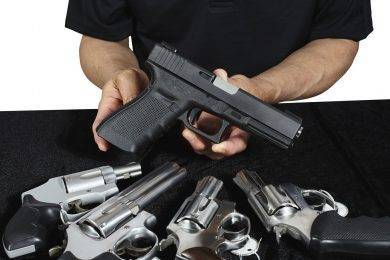About 4 in 10 U.S. adults say they live in a household with a gun.
A common type of gun owned by residents is the rifle. Since its invention in the early 1700s, the rifle has been one of the most reliable pieces of weaponry in the gun industry. You can use it for hunting or self-defense.
While the engineering, creativity, and cosmetic prowess poured into rifles today may be unlimited, they still fall in different types defined by how they operate. Knowing the different types of rifles will help you get a better understanding of how to handle them effectively and safely.
Below is a guide of the distinct types of rifles that exist.
Break-Action Rifle
Do you need a large caliber gun for hunting big game?
You should consider getting the break-action rifle. Although it is relatively rare in firearm stores, this back-to-basics gun still exists. Break-action rifles can have a single barrel or a double barrel. Operating this rifle is straightforward.
It’s hinged just like a door, making rotation easy. The barrel and receiver rotate perpendicularly to the bore axis to expose the breech. This allows the loading and unloading of cartridges.
After inserting ammunition, the break-action rifle may not be ready to fire. This is an added safety feature, especially for beginners. When left open like this, it eliminates any chance of a negligent discharge.
You may also need to reset the hammer in some break-action rifles. In others, it can reset upon closing but the safety can automatically engage. The break-action rifle also has multiple triggers that allow shooters to select the cartridge with each pull of the trigger.
Lever Action Rifles
Lever actions are America’s rifle that was for a while known as the kings of the whitetail woods. From the Henry Rifle to the Winchester rifle, the lever actions dominated the 1800s. But you can get can still get this type of rifle today since modern manufacturing continues.
Although they have a simple look, they can be complicated to put together. If done right, you can get an effective, yet nostalgic experience when firing.
The lever-action rifle has a large metal lever located behind the trigger. You need to push the lever downward and forward to open the action. This motion extracts the cartridge case from the chamber and ejects it. If your magazine holds extra cartridges, they can be immediately loaded into the chamber.
In case you want to unload the lever-action rifle, repeatedly push the lever downward and forward until no more cartridges are expelled. Since it’s hard to tell if this type of rifle, open the action, and check both the chamber and the magazine to confirm.
Most lever-action rifle models also have an exposed hammer and it can be dangerous. When working this rifle, ensure you keep your hands away from the trigger.
Falling-Block Action Rifles
Also known as a sliding-block action or dropping-block action, a falling-block action rifle is a single-shot firearm receiver. It’s more rigid and accurate than a break-action. To load it, you should move a lever under the rifle so that the rear of the action can fall or roll away. When you move the lever back, the rear of the action closes.
Since falling-block actions are the most rigid, they allow you to stay on target when reloading. However, they are difficult to manufacture. This means it’s hard to find a cheap falling-block action rifle.
Pump Action Rifles
Right after the lever action, the pump action is one of the earliest repeating rifles in the U.S. Similar to an old hunting truck, pump-action rifles may not be fancy but they are reliable hunting tools you can use every season. They’re the perfect blend of balance and speed due to their smooth and crisp cycling and lightning follow-ups.
These rifles are available as centerfire and rimfire and centerfire. Some calibers for centerfires include .308 Winchester .243 Winchester, and .280 Remington.
To operate it, you have to fill the magazine with three or more cartridges. There will be tension in the magazine from a spring so you have to pull the fore-end to the rear of the rifle. This will discharge anything in the chamber, cock the hammer, and load the shell in the chamber.
Next, you need to push the slide forward. It’ll then push the block and firing pin into the gunfire position against the cartridge. Then, you can fire and repeat this motion to reload the rifle and eject used cartridges.
Semi-Automatic Action Rifles
Also referred to as auto-loading actions, semi-automatic action rifles use the energy from rapidly expanding gas or recoil to cycle the action and load the next round. An example of a semi-automatic rifle is the AR-15, which you can customize with the aftermarket AR-15 handguard to enhance the look, feel, and functionality.
Although you fire it manually, the case of the cartridge is ejected automatically. Also, the chamber’s reloaded automatically. During operation, you should pull back the bolt’s operating handle to open the action.
It’ll lock in the open position if the magazine is empty. In case it doesn’t lock open, the cartridge from the magazine may have gone into the chamber, making the rifle ready to fire.
To unload, remove the magazine, and then lock the action open. Ensure it’s unloaded by checking both the chamber and the magazine for extra cartridges. Unlike a fully automatic firearm, you must pull the trigger each time you want to fire your semi-automatic action rifle.
Bolt Action Rifles
Still common today among snipers and long-range shooters, the bolt action rifle is known for its lesser weight, superior accuracy, reliability, and capability to control loading over the faster rate of fire. Most bolt action rifles have magazines but capacity varies depending on the model and cartridges the rifle uses.
It operates like opening and closing a door bolt. The bolt firmly locks into the breech, making it accurate and reliable. If you want to open the action, lift the handle and pull it to the rear. For a loaded rifle, the cartridge or shell will be discharged when you pull the bolt to the rear.
Ensure it’s unloaded by opening the action and checking the chamber and the magazine for shells or cartridges. To store your bolt-action rifle safely, you should store the bolt separately from the firearm.
Factors that Determine Accuracy of Different Types of Rifles
Accuracy is important when firing your rifle. Although all rifles should be accurate, there is a difference between the various types of guns. Here are things that increase or reduce your rifle’s accuracy:
Rigidity
When it comes to your action’s accuracy, rigidity is one of the most important factors. If you have a more rigid action rifle with fewer moving parts, it’ll be more accurate when you fire. Rifles like the falling-block action and the break-action are more accurate since very little of their receivers’ move.
Alignment
This refers to the tight tolerances for the receiver threads, bolt lugs, bolt face, and other machined parts on your rifle. For more consistent shots, each part must fit tightly. However, alignment varies depending on the manufacturer and any aftermarket blueprinting.
Movement
Does your rifle move after firing? A rifle that moves after firing may be hurting your accuracy. Accurate rifles contain the least amount of movement once you fire.
Trigger
Having a good trigger is vital for accurate shooting. This is because any movement of the rifle caused by pulling the trigger can affect the placement of your shot. That’s why you should ensure you use a trigger that works well.
Also, remember to adjust the trigger for the type of shooting you’re doing. When squeezing the trigger, apply slow, steady pressure until your rifle fires. It’ll stop the gun from jarring.
Barrel
The quality and specifications of your rifle’s barrel will also affect your precision when firing. The best rifles have barrels made of top-grade steel and detailed manufacturing methods to help them become more accurate.
To ensure you get consistent accurate shots, you should check the consistency of your barrel’s bore by slugging it and feeling for loose or tight spots. This way you can identify changes in your bore’s dimensions. What’s more, your gunsmith can affect the performance of your barrel and the accuracy of your shots during machining.
Muzzle Crown
When firing your rifle, the muzzle crown in your barrel is the last surface your bullet passes before it begins its flight path. If the muzzle crown is imperfect, your accuracy can reduce.
Environmental Conditions
Barometric pressure, temperature, humidity, and wind can also affect your rifle’s precision. For example, if it’s windy, your accuracy may be lower due to increased movements in your surroundings.
Become a Responsible Rifle Owner
Gun ownership comes with a lot of responsibility. If you own a rifle, you should understand firearm essentials like the handling and storing your rifles well to avoid any gun-related tragedies. First and foremost, know about the different types of rifles mentioned.
To learn more about guns, stay tuned to our blog!











